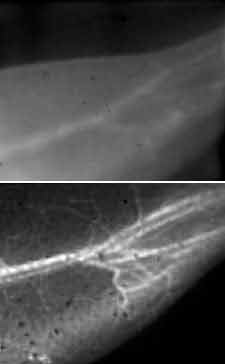Near Infrared-2 Imaging Technology Developed for Visualizing Blood Flow
By MedImaging International staff writers
Posted on 26 Dec 2012
Investigators have developed a fluorescence imaging technique that provides a view of the pulsing blood vessels of living animals with never-before-seen clarity. Compared with traditional imaging technologies, the sharpness enhancement is similar to cleaning fog off eyeglasses.Posted on 26 Dec 2012
The technique, called near infrared-2 imaging (NIR-2), involves first injecting water-soluble carbon nanotubes into the live subject’s bloodstream. The researchers then shine a laser (its light is in the near-infrared range, a wavelength of about 0.8 micrometers) over the subject—in this instance, a mouse. The light causes the specially engineered nanotubes to fluoresce at a longer wavelength of 1-1.4 micrometers, which is then detected to determine the blood vessels’ structure.

Image: These images of a mouse's blood vessels show the difference in resolution between traditional near-infrared fluorescence imaging (top) and Stanford's new NIR-2 technique (bottom) (Photo courtesy of Stanford University).
That the nanotubes fluoresce at considerably longer wavelengths than conventional imaging techniques is vital in achieving the amazingly sharp images of the tiny blood vessels: longer wavelength light scatters less, and thereby generates clearer images of the vessels. Another advantage of detecting such long wavelength light is that the detector registers less background noise since the body does not produce autofluorescence in this wavelength range.
In addition to providing fine details, the technique, developed by Stanford University (Stanford, CA, USA) scientists Hongjie Dai, PhD, professor of chemistry; John Cooke, MD, PhD, professor of cardiovascular medicine; and Ngan Huang, PhD, acting assistant professor of cardiothoracic surgery—has a fast image acquisition rate, allowing researchers to measure blood flow in near real time.
The research was published online November 18, 2012, in the journal Nature Medicine. The ability to obtain both blood flow data and blood vessel clarity was not earlier possible, and will be especially useful in studying animal models of arterial disease, such as how blood flow is affected by the arterial blockages and constrictions that cause, among other things, heart attacks and stroke. “For medical research, it’s a very nice tool for looking at features in small animals,” Prof. Dai said. “It will help us better understand some vasculature diseases and how they respond to therapy, and how we might devise better treatments.”
Because NIR-2 can only penetrate 1 cm, at most, into the body, it will not replace other imaging techniques for humans, but it will be a powerful method for studying animal models by replacing or complementing computed tomography (CT), X-ray, magnetic resonance imaging (MRI), and laser Doppler techniques.
The next phase of the research, and one that will make the technology more easily accepted for use in humans, is to study alternative fluorescent molecules, according to Prof. Dai. “We’d like to find something smaller than the carbon nanotubes but that emit light at the same long wavelength, so that they can be easily excreted from the body and we can eliminate any toxicity concerns.”
Related Links:
Stanford University














